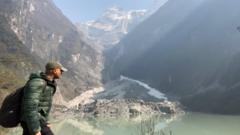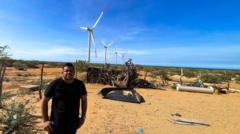Residents of Sarandí express anxiety as the canal's water glows bright red, prompting an examination into the potential causes linked to industrial waste disposal.
**Argentina's Sarandí Canal Turns Red, Raising Environmental Concerns**

**Argentina's Sarandí Canal Turns Red, Raising Environmental Concerns**
A mysterious red hue in a Buenos Aires suburb spurs alarm among locals and investigations into pollution sources.
On Thursday, the Sarandí canal, located in a suburb of Argentina's capital, Buenos Aires, startled local residents with its unusual bright red appearance. Images captured in the area showcased the strikingly vivid water streaming into the neighboring Rio de la Plata, an estuary adjacent to an ecological reserve. Concerns mounted as media outlets speculated that the alarming color change could be attributed to the improper disposal of textile dyes or chemical byproducts from local industries.
In an official response, Argentina's Environment Ministry announced that they had collected water samples from the affected canal to investigate the source of the vibrant coloration. By late afternoon, the intensity of the red hue reportedly began to diminish, although residents remained on edge.
Locals have long suspected that numerous companies in the vicinity are discharging hazardous waste into the canal, which flows through a densely populated area known for its leather processing and textile factories—approximately 10 kilometers (6 miles) from downtown Buenos Aires. Silvia, a concerned resident, conveyed her dismay to local news, recalling, "Although it has turned red now, there have been other times when it was yellow, with an acidic smell that makes us sick even in the throat."
Another resident, Maria Ducomls, echoed these sentiments, noting the canal’s changing colors over time— from bluish and green to pink and lilac, often accompanied by a greasy surface. The troubling situation has spurred a call for accountability regarding local industrial waste management practices and the potential hazards posed to the environment and the health of nearby communities.
In an official response, Argentina's Environment Ministry announced that they had collected water samples from the affected canal to investigate the source of the vibrant coloration. By late afternoon, the intensity of the red hue reportedly began to diminish, although residents remained on edge.
Locals have long suspected that numerous companies in the vicinity are discharging hazardous waste into the canal, which flows through a densely populated area known for its leather processing and textile factories—approximately 10 kilometers (6 miles) from downtown Buenos Aires. Silvia, a concerned resident, conveyed her dismay to local news, recalling, "Although it has turned red now, there have been other times when it was yellow, with an acidic smell that makes us sick even in the throat."
Another resident, Maria Ducomls, echoed these sentiments, noting the canal’s changing colors over time— from bluish and green to pink and lilac, often accompanied by a greasy surface. The troubling situation has spurred a call for accountability regarding local industrial waste management practices and the potential hazards posed to the environment and the health of nearby communities.























